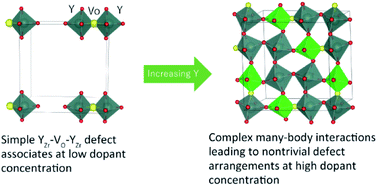Dopant arrangements in Y-doped BaZrO3 under processing conditions and their impact on proton conduction: a large-scale first-principles thermodynamics study
Abstract
Y-doped BaZrO3 is an ion conductor under intense research for application in medium temperature solid oxide fuel cells. The conductivity is maximized at ∼20% doping, and the decrease with further doping has often been attributed to the association effect, or the trapping of ionic charge carriers by the dopant. This seems like a reasonable conjecture since the dopant and carrier are charged in opposite polarities and should attract each other. However, at such high doping concentrations, many-body interactions between nearby dopants and carriers are likely to modify such a simple two-body attraction picture. Thus, in this work, we employ a large-scale first-principles thermodynamic sampling scheme to directly examine the configuration of dopants and charge-compensating defects at realistic doping concentrations under processing conditions. We find that although there is, indeed, a clear  association effect at all doping concentrations examined, the magnitude of the effect actually decreases with increasing dopant concentration. We also find that
association effect at all doping concentrations examined, the magnitude of the effect actually decreases with increasing dopant concentration. We also find that  interactions cannot simply be understood in terms of two-body Coulomb attraction and repulsion, highlighting the importance of many-body effects in understanding the defect chemistry in heavily doped oxides. Finally, we examine the dopant configurations and successfully explain the conductivity maximum based on a percolation vs. many-body trapping picture that has gained attention recently.
interactions cannot simply be understood in terms of two-body Coulomb attraction and repulsion, highlighting the importance of many-body effects in understanding the defect chemistry in heavily doped oxides. Finally, we examine the dopant configurations and successfully explain the conductivity maximum based on a percolation vs. many-body trapping picture that has gained attention recently.



 Please wait while we load your content...
Please wait while we load your content...
